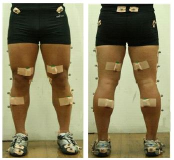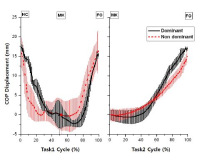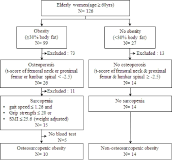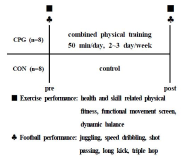
The purpose of this research is to investigate the factors affecting the performance capability of lunge movements by performing lunge movements which are commonly used as a method of instant physical movement in sports with a kinetic analysis including an EMG analysis. This research targeted 14 skilled fencers and made the subjects perform kick-lunges which allow them to go farthest from their positions and performed an analysis on such, applying a 3D motion analysis system and an EMG system. The subjects performed kick-lunges in two movements; one with a preliminary movement and the other without it and those are performed with both dominant leg and non-dominant leg. The result of this research is as follows. The lunges with a preliminary movement showed higher performance capability than those without it. Furthermore, as the level of skills gets higher, the length of lunges gets longer, and it seemed that a tactical mechanism shortening exercise performance times was used as a mechanism to control the impulse coming from such lengthened lunges. In addition, a difference appeared in mechanical factors such as moment and power in a dominant leg movement and it seemed to result from a difference in an functional capability using muscles.





PURPOSE This study sought to analyze the velocity and asymmetry between bilateral lower extremity mechanics according to the load during walking. METHODS A total of 14 adults with right leg dominance participated in this study (Male=7, Female=7). We respectively applied 30% of body weight load carriage on the subjects. Gait characteristics were analyzed with 3-dimensional cinematography and ground reaction force (GRF) system consisted of a center of gravity (COG) velocity, center of pressure (COP) area, leg stiffness, and GRF components. RESULTS Change in velocity of the maximum-minimum COG showed statistically significant in the main effect of load. The 1st anterior-posterior GRF (braking force) and vertical GRF were statistically significant in the main effects of load and bilateral lower limbs. The 2nd anterior-posterior GRF (propulsive force) was statistically significant in the main effect of load. COP area and leg stiffness exhibited statistically significant differences in the main effects of load and bilateral lower limbs. Interaction was observed in the vertical GRF, COP area. Furthermore , one-way variance analysis revealed load main effect had a greater influence on the increase in the magnitude of the vertical GRF and COP area than the asymmetry of bilateral lower limbs. CONCLUSIONS This study revealed the differences in asymmetry between the dominant and non-dominant lower limbs according to the load during walking. These findings may explain the differences shock attenuation and stress mechanisms between the bilateral lower limbs.
PURPOSE This study aimed to investigate the effect of an ankle strap on kinetic variables of the lower limb during forward jump landing. METHODS Twelve healthy adult men (mean age, 23.58±2.22 years; mean height, 177.83±5.37 cm; mean weight, 75.00±7.72 kg) participated. The participants stood barefoot on both legs at a horizontal distance of 40% of their body height from the center of the force plate, then jumped forward and landed on the force plate with their dominant or non-dominant leg over a 30-cm hurdle while wearing or not wearing an ankle strap. Joint angle, peak vertical force, loading rate, and leg stiffness were calculated. Paired t-test and repeated-measures two-way analysis of variance with Bonferroni’s post hoc tests were used to compare the characteristics of both lower limbs and the effect of wearing an ankle strap. The significance level was α < .05 RESULTS Our results showed significant differences in kinematic variables between the dominant and non-dominant legs without the ankle strap. With the ankle strap, the inversion angles at the ankle joints of both lower extremities were significantly decreased, and an interaction effect between both legs and the ankle strap occurred in the internal rotation angle of the ankle joint. Kinetic variables did not differ significantly. CONCLUSIONS The ankle strap did not completely compensate for ankle instability in the non-dominant leg, but it significantly reduced the angle of internal rotation at the ankle joint. Thus, we recommend that correct wearing of the ankle strap in sports since it reduces the possibility of lateral ankle sprains to some extent.

Purpose The purpose of this study were to assess physiological and biochemical characteristics in elderly women with osteosarcopenic obesity (OSO), and to analyze relationships among irisin, adipokines and bone metabolism markers. Methods 126 elderly women were selected and among them 10 women were classified into OSO group (76.9±5.2 yrs) and 14 women were classified as a NOSO group (72.9±5.6 yrs). Physique, body composition and bone mineral density were measured. Senior fitness tests were 30-s chair stand, 30-s arm curl, chair sit-and-reach, back scratch, 8-foot up-and-go, grip strength, and 2-min step test. Isokinetic muscle strength was measured by isokinetic dynamometer (Cybex 770, USA). Nutrition intake and physical activity were administered. Biochemical parameters including irisin, FNDC-5, leptin, adiponectin, CTx, 25(OH)D, osteocalcin, and PTH were measured. All data were analyzed by SAS 9.4. Independent t-test was applied to compare between OSO and NOSO groups. Multiple regression analysis was used. The level of significance was set at .05. Results The results of the study showed that there were significantly high for waist circumference, hip circumference, WHR, and BMI in OSO group compared to those of NOSO group. Higher results were also obtained for fat tissue and percent body fat but significantly low for lumbar bone mineral density. OSO group showed significant lower results for grip strength and 2-min step test compared to NOSO group. Peak torque, and relative peak torque at 60° were significantly lower for left and right knee flexion in OSO group. Protein intake was significantly low in OSO group, but no difference was obtained in level of physical activity between two groups. Irisin was significantly related to adiponectin, FNDC-5 and osteocalcin in explaining 35.2%, 81.5% and 92.1% of the variance, respectively. Conclusions This study shows that elderly women with OSO have higher results for physique and body composition parameters except body height. However, lower values were obtained for functional fitness, and isokinetic muscle strength. OSO may have more risks for metabolic syndrome, bone fractures, fall, lack of daily physical activity and limit of locomotion due to the imbalance of quadriceps and biceps femoris in non dominant leg. This study suggests that criteria and mechanism of OSO should be clarified by follow-up study.

PURPOSE This study aimed to: 1) compare the differences in static lower-extremity alignment (SLEA) between female ballet dancers (BD) and non-ballet dancers (NBD); 2) investigate the differences among gesture leg (GL) and supporting leg (SL) in BD and dominant leg (DL) in NBD; and 3) compare limb asymmetry between groups. METHODS Twenty-nine female BD and 20 NBD were recruited for this study. The quadriceps, tibiofemoral, rearfoot, and genu-recurvatum angles, tibial torsion and varum, and navicular drop height were measured. An independent t-test was conducted to compare SLEA and limb asymmetry between groups. One-way analysis of variance with Bonferroni post-hoc tests were performed to determine the differences among the GL, SL and DL. RESULTS BD showed lower quadriceps and rearfoot angles, less tibial varum and navicular drop, and greater tibiofemoral angle (p<.005) than NBD. BD showed less quadriceps angle asymmetry but greater tibial torsion asymmetry (p<.01) than NBD. GL and SL in BD showed differences in quadriceps, tibiofemoral, rearfoot angle, tibial torsion and navicular drop compared to NBD. CONCLUSIONS Repetitive dance movements can transfer varying forces to the GL and SL, potentially contributing to SLEA asymmetry. An intervention strategy that can reduce SLEA asymmetry in BD is needed, as is the identification of elements of ballet training that contribute to maintaining a normal SLEA.
PURPOSE This study aimed to present isokinetic quadriceps and hamstring muscle strength values in K league 1 (K1) professional soccer players and compare these results to those of published studies. METHODS A total of 31 K1 soccer players (age 24.5±4.2) without a history of lower limb injury were included in this study. Isokinetic knee strength tests were implemented at a velocity of 60°·s-1 and 180°·s-1 for both dominant (D) and non-dominant (ND) legs using a dynamometer. Strength variables included peak torque (PT), body mass normalized PT (NPT), bilateral strength difference (BD), and hamstring to quadriceps strength (H/Q) ratio. RESULTS At 60°·s-1 velocity, the NPTs of the quadriceps were 3.39N·m·kg-1 and 3.33N·m·kg-1 for D and ND legs, respectively, and those of the hamstrings were 2.00N·m·kg-1 and 1.89N·m·kg-1 for D and ND legs, respectively. At 180°·s-1 velocity, the NPTs of the quadriceps were 2.31N·m·kg-1, 2.27N·m·kg-1 for D and ND legs, respectively, and those of the hamstrings were 1.42N·m·kg-1, 1.39N·m·kg-1 for D and ND legs, respectively. At all velocities, the BDs of quadriceps and hamstring muscles ranged from 6.6–7.8%, and H/Qs ranged from 57–62%. Compared to previous studies that did not consider the history of injury, this study showed lower levels of BD (less than 10%) and higher levels of NPT. CONCLUSIONS The presented isokinetic quadriceps and hamstring muscle strength values can be used as reference values for the isokinetic knee strength of K1 professional soccer players.

[Purpose] This study aimed to examine the effects of complex physical training on exercise and football performances in youth football players. [Methods] The subjects (n=16) were randomly assigned to either a complex physical training group (CPG, n=8) or a control group (CON, n=8). CPG was performed the complex physical training for 50 minute per day, and 2∼3 times per week, for 8 weeks. Exercise performance (health related physical fitness, skill related physical fitness, Y-balance and functional movement screen; FMS) and football performance (juggling, speed dribbling, shot passing, long kick and triple hop) were measured before and after 8 weeks complex physical training. [Results] Sit-up (p=0.002), sit and reach (p=0.040), 50-m run (p=0.031), side step (p=0.005), single-leg standing with eyes closed (p=0.040), plank (p=0.023), dominant composite score (p=0.002) and non-dominant composite score (p=0.005), deep squat (p=0.009), inline lunge (p=0.042), active straight leg-raise (p=0.015), rotary stability (p=0.049), total score(p=0.001), speed dribbling (p=0.030), dominant triple hop (p=0.001) and non-dominant triple hop (p=0.032) were statistical significant interactions between group and time. [Conclusion] Our findings indicate that complex physical training has beneficial effects on performance improvement of exercise and football in youth football players.


PURPOSE This study investigates the impact of injury experience on ankle dorsiflexion, quadriceps extensibility, and dynamic stability in elite adolescent and adult volleyball players. METHODS A total of 485 players (adolescents=337, adults=115) reported lower extremities injuries, with measurements taken for ankle dorsiflexion and quadriceps extensibility using the weight- bearing lunge test and Ely’s test, respectively. The Y-balance test was used for dynamic stability. Measurements were conducted on the injured leg of players with knee and/or ankle injuries and the dominant leg of healthy players. Four groups were classified based on injury experience, and comparisons were made between both legs. Additionally, the variables of adolescent players were compared to those of adults. RESULTS Adolescent players with knee injuries exhibited a larger difference in ankle dorsiflexion between both legs, while adult players with ankle injuries demonstrated an asymmetry of ankle dorsiflexion. Regardless of age, players with knee or ankle injuries displayed lower dynamic stability compared to healthy players. Notably, adults with knee injuries showed a larger difference in dynamic stability between both legs. CONCLUSIONS To prevent and rehabilitate volleyball-related injuries, comprehensive injury risk factors, including age, should be managed in the injury prevention strategies.
PURPOSE This study aimed to identify the lower limb muscle activity based on direction prediction presence or absence and gender during side cutting in healthy college students. METHODS The study participants included 14 healthy males and females (8 males; 6 females). All participants ran at full speed for a distance of 12m, and side-cutting was carried out at 45 degrees in a randomly indicated direction and in a fixed direction. Simultaneously, data regarding vastus medialis, vastus lateralis, semitendinosus, and biceps femoris muscle activity of the dominant leg were collected using an electromyography sensor, and data regarding vertical acceleration were collected using an inertial sensor attached to the pelvis. A sync webcam was used for obtaining the initial contact of side cutting and the stance period time. During the 10 milliseconds (pre-activation) prior to the initial contact and 50% of the stance phase (loading phase), vastus medialis, vastus lateralis, semitendinosus, and biceps femoris average muscle activity and hamstring to quadriceps ratio included as variables. RESULTS During the pre-activation and loading phase, the vastus medialis muscle activity of the male group was higher in the unexpected condition than in the expected condition. Furthermore, hamstring to quadriceps ratio was confirmed to be lower under unexpected condition compared to under expected condition during on loading phase. CONCLUSIONS The study results suggest that the risk of anterior cruciate ligament injury may increase with side cutting under unpredictable conditions. It is expected to provide useful information for identifying factors related to knee injury in the general population.